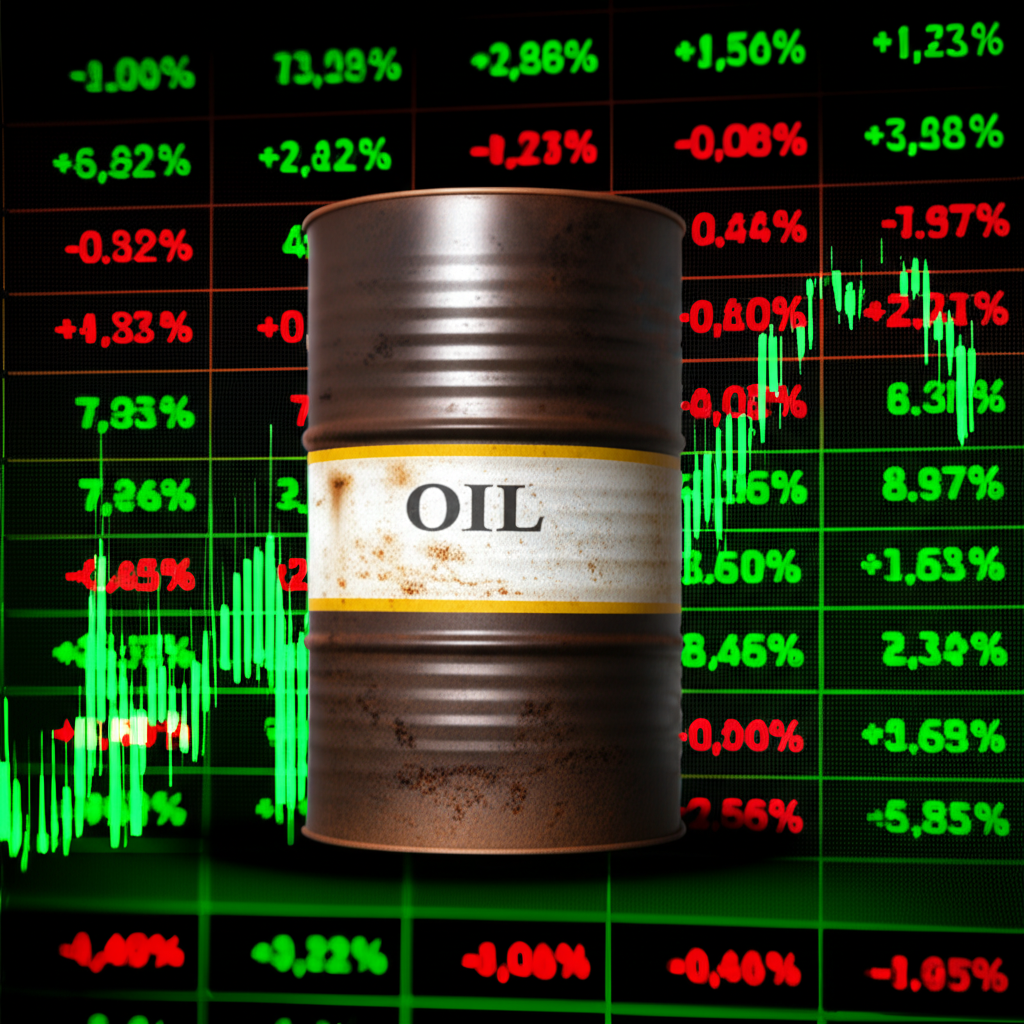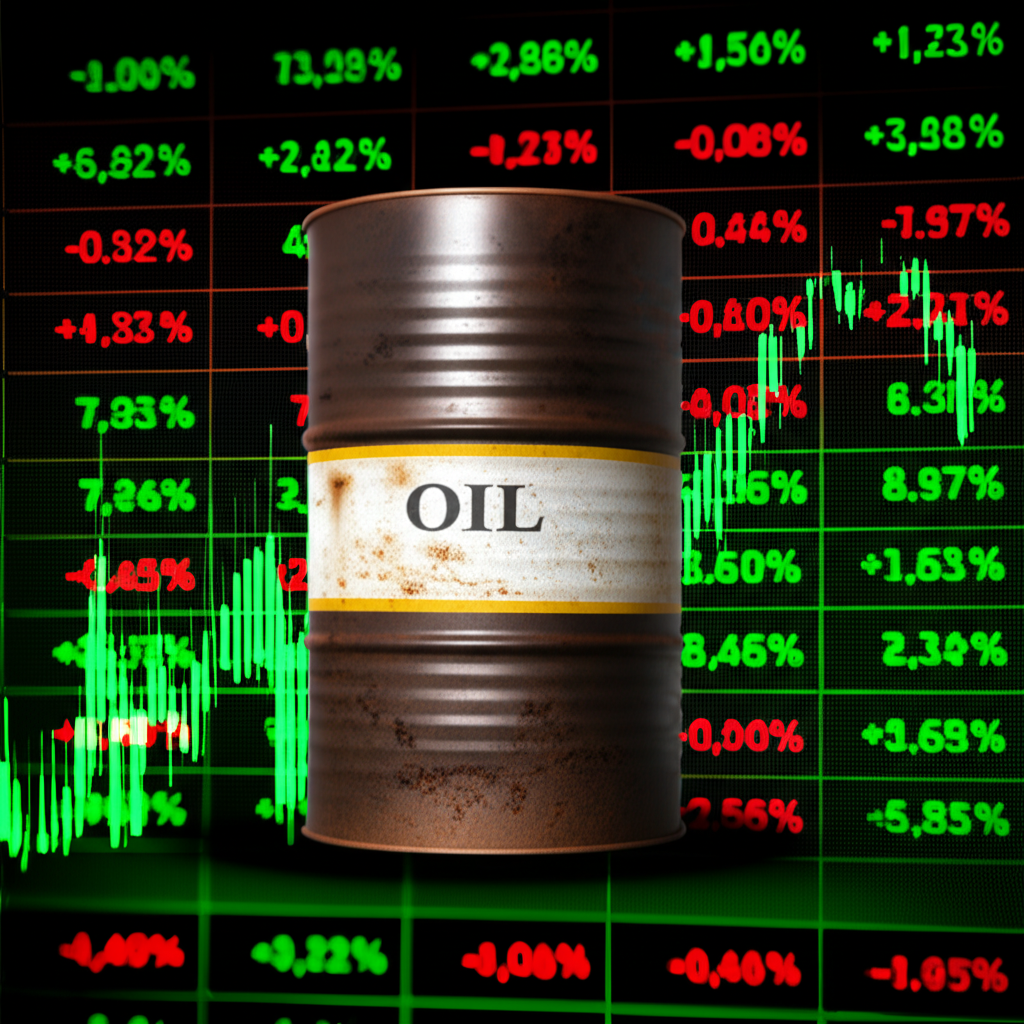The interplay between crude oil prices and the U.S. stock market remains a key concern for investors, policymakers, and economists. Heading into 2025, grasping this often unpredictable connection is crucial for American traders aiming to sharpen their strategies. As a cornerstone commodity worldwide, oil serves as both a gauge of economic health and a force that shapes it, sending waves through consumer budgets, business profits, and sectors throughout the U.S. economy.

For U.S. investors, unpacking these forces goes beyond theory-it’s about spotting real opportunities in market trends, sector shifts, and inflation signals. This overview explores how oil prices affect American equities, highlights the main influences on crude for 2025, draws from past events, and shares targeted tactics to help traders handle the shifting terrain.

Understanding the Relationship Between Oil Prices and Stock Markets in the United States
Crude oil prices and U.S. stock indices rank among the top metrics watched by market participants, forming a vital part of economic evaluations. Oil benchmarks like West Texas Intermediate (WTI) and Brent Crude set the per-barrel value, while stock gauges such as the S&P 500, Dow Jones Industrial Average, and Nasdaq Composite capture the performance of listed U.S. firms.
This link between oil and stocks isn’t straightforward-it can align closely or pull apart depending on conditions. Oil’s influence arises from its position as an essential cost for industries and a big chunk of household budgets, plus its status as a powerhouse sector. In the U.S., the biggest oil consumer and a top producer, these elements deeply affect growth, inflation, profits, and stock values. Come 2025, changes in energy rules, international tensions, and tech progress will layer on fresh complexities to this dynamic.
Direct and Indirect Impacts of Oil Prices on US Stock Markets
Crude oil’s sway over U.S. stocks operates through multiple pathways, hitting individual industries and the wider economy.
Impact on Corporate Earnings and Sector Performance
Shifts in oil prices reshape expenses and income for businesses, directly altering their bottom lines and share prices.
- Energy Sector: The effect hits hardest here. Soaring crude costs usually lift earnings for exploration and production outfits, as their output fetches higher rates. Refiners, though, may face tighter margins if raw crude jumps quicker than what they charge for fuels. Service providers in oilfields also gain when producers ramp up spending amid price booms.
- Transportation (Airlines, Shipping, Trucking): Fuel makes up a large slice of costs in these areas. Spiking oil drives up expenses for jet fuel, diesel, and gas, cutting into profits for carriers and haulers. Firms might hike ticket or shipping fees to cope, which could soften demand, or just absorb the hit to earnings.
- Consumer Discretionary: Pump prices climbing squeeze household wallets, curbing extras like restaurant meals, movies, or big-ticket buys. Retailers, hotel chains, and carmakers in this space often see sales dip, dragging down results.
- Manufacturing: Factories lean on energy for power from coal or gas plants and plastics from oil byproducts. Elevated prices inflate material and running costs, pinching margins in everything from autos to appliances.
- Renewable Energy: Interestingly, pricier oil can favor green alternatives. Costlier fossils make solar panels, wind turbines, and other renewables look better by comparison, spurring U.S. investments and lifting stock values for clean-tech players.
Inflation and Monetary Policy in the US
A major ripple from higher oil is its role in stoking inflation, which then shapes the Federal Reserve’s moves.
- Rising Oil Prices Contribute to Inflation: Oil feeds into costs for shipping, factory output, and home heating. This fuels “cost-push” inflation, showing up in U.S. trackers like the Consumer Price Index (CPI) and Producer Price Index (PPI).
- Federal Reserve’s Response: With a mandate for steady prices, the Fed tracks inflation closely. Energy-driven surges might trigger rate increases to temper the economy by raising borrowing costs for all.
- Implications for US Bond Markets and Equity Valuations: Rate jumps devalue existing bonds while yields climb on new ones. For stocks, pricier debt hampers company expansion and earnings outlook, plus it discounts future profits more harshly-hitting growth-oriented names especially hard.
Consumer Spending and Economic Growth
U.S. growth hinges on what people buy, and oil prices can crimp that flow.
- High Gas Prices Drain Consumer Pockets: Transport eats a hefty share of family budgets. Sky-high gas siphons off cash for fun and extras, slowing overall purchases and economic momentum.
- Impact on US GDP Growth Projections: Since spending drives most of GDP, prolonged oil spikes and thriftier consumers can prompt analysts to trim growth estimates, hinting at slowdowns or worse.
- Business Investment Decisions: Firms weigh energy bills in their plans too. Unstable prices breed hesitation, leading to postponed projects that curb hiring and expansion across America.
Key Factors Driving Oil Prices and Their Implications for 2025
Predicting crude prices is tough, but spotting the core influences helps U.S. investors prep for 2025.
Supply and Demand Dynamics
Basic economics-supply versus demand-still rules oil pricing.
- OPEC+ Decisions and Production Cuts: OPEC and its partners control much of the world’s output. Their quota choices or slashes will tip supply balances in 2025, depending on unity or rifts.
- US Shale Oil Production: America’s shale boom has made it a quick-response supplier. Investments and innovations in fracking will shape how much extra crude hits the market next year.
- Global Economic Growth Forecasts: Demand ties to worldwide activity, especially in powerhouses like China, India, and the U.S. Booming growth means more fuel for travel, factories, and power plants; slumps do the reverse. Watch IMF and World Bank projections for clues.
Geopolitical Events and Global Stability
World events often override economics, adding sharp swings to oil.
- Conflicts in Oil-Producing Regions: Trouble in spots like the Middle East or Ukraine can halt flows, wreck facilities, or spark shortage fears, sending prices soaring.
- Sanctions and Trade Policies: U.S. or EU penalties on exporters cut supply; tariffs tweak regional flows too.
- Impact on Supply Chain Disruptions: Tensions ripple to gear and workers needed for drilling and shipping, amplifying price chaos.
The US Dollar’s Strength and Commodity Pricing
Oil trades in dollars globally, so currency swings matter.
- Inverse Relationship: A robust dollar hikes oil’s cost abroad, cooling demand and prices. A softer dollar eases it for others, potentially lifting volumes and values.
- Federal Reserve Policy: Fed rate paths sway the dollar’s power. Expected tweaks in 2025 will indirectly nudge crude through this channel.
Energy Transition and Climate Policies in 2025
Bigger-picture changes in how we use energy are reshaping demand.
- Growing Adoption of Renewable Energy: The shift to low-carbon sources is speeding up in the U.S. and beyond, nibbling at oil’s share over time.
- Government Policies (e.g., US Clean Energy Initiatives): Tax breaks for EVs, green infrastructure funds, and tougher emission rules aim to wean off fossils. 2025 plans will refine long-haul demand views.
- Impact of ESG Investing Trends: Investors prioritizing environment, social issues, and governance are pulling back from oil firms, tightening their funding even as short-term needs persist.
Historical Perspective: Major Oil Shocks and US Stock Market Reactions
Past upheavals teach U.S. traders how stocks respond to oil jolts.
- 1970s Oil Crises and Stagflation: The 1973 embargo and 1979 revolution quadrupled prices, sparking U.S. recessions with rampant inflation and joblessness-stagflation. Stocks languished in extended slumps.
- Early 2000s Oil Boom and Bust: Prices rocketed to mid-2008 on China-led demand and conflicts, fueling energy stocks but inflation. The crash that followed tanked oil and equities alike.
- 2008 Financial Crisis and Oil Price Collapse: Global panic crushed demand, plunging WTI from $140-plus to under $40. This synced with stock freefalls, showing crises trump other drivers.
- COVID-19 Pandemic and Negative Oil Prices: Lockdowns in 2020 cratered usage, plus oversupply, flipping WTI futures negative briefly. Stocks plunged then rebounded on aid, decoupling somewhat from oil’s dive.
- Lessons Learned for US Investors: Sudden supply-driven spikes often herald slowdowns, while demand-fueled rises are easier to weather. Context-supply crunch or growth surge-guides the market’s path, positioning oil as both signal and spark.
Navigating Oil Price Volatility: Strategies for US Investors and Traders in 2025
With oil’s ups and downs touching so many areas, American investors need solid plans for 2025.
Diversification and Hedging
Building a balanced setup shields against surprises.
- Importance of a Diversified Portfolio: Spread bets beyond oil-tied sectors. Mix stocks, bonds, property, commodities, and regions to blunt hits from one corner.
- Using ETFs, Futures, or Options to Hedge: If energy exposure looms large, targeted tools can offset risks.
- ETFs (Exchange-Traded Funds): Funds like USO or BNO mirror oil prices or energy firms, ideal for bets or buffers.
- Futures Contracts: Big players lock rates via WTI futures on NYMEX, guarding against swings.
- Options: These on futures or ETFs cap downside while keeping upside open, at a set strike.
Identifying Opportunities in Specific Sectors
Price swings open doors and pitfalls in U.S. industries.
- Consider Renewable Energy, Technology, or Consumer Staples: In oil spikes, look to low-fuel sectors or winners like renewables, efficient tech, or steady essentials that hold up in tough times.
- Analyzing Company-Specific Exposure: Zoom in on firms: What’s their energy bill? Do they hedge? Can they raise prices? Fuel-sippy airlines with smart strategies, for example, outperform rivals.
Trading Crude Oil and Energy-Related Assets in the US
Active U.S. traders seeking straight oil plays have options, but regulations shape access-especially for CFDs, which many domestic brokers skip for retail folks.
- Overview of How US Traders Can Access Crude Oil Markets:
- Futures: NYMEX WTI contracts offer liquid, leveraged entry for price plays.
- ETFs: Simpler than futures, these track prices, rolls, or energy baskets.
- Options: On futures or ETFs, they let traders bet with risk limits.
- Factors to Consider When Choosing a Broker for Oil Trading:
- Regulation: Stick to CFTC/NFA oversight for futures/options; overseas CFDs mean varied safeguards.
- Platform and Tools: Seek solid setups like MT4/5 or cTrader with charts and quick trades.
- Spreads/Commissions: Low costs suit frequent movers.
- Market Access: Confirm WTI, Brent, and related assets.
- Customer Support: Quick, expert help counts.
Top Brokers for Trading Oil & Energy Assets (2025)
U.S. rules limit retail CFDs on oil domestically, pushing traders to futures or ETFs via approved firms, or international options for expats. We spotlight brokers strong in energy, noting U.S. client limits.
1. Moneta Markets: This broker, holding an FCA license, skips U.S. retail CFD clients per regulations but excels worldwide with tight oil CFD spreads, MT4/MT5 access, and broad energy markets. For non-U.S. residents or global diversification, its easy tools, support, and analytics shine for tracking oil shifts.
2. OANDA: A trusted name for Americans under NFA/CFTC rules, OANDA focuses on forex but extends to commodities and indices via CFDs where allowed abroad. Its intuitive platform and deep research suit U.S. traders eyeing regulated energy access.
3. IG: This global powerhouse opens U.S. accounts to futures/options on oil, or CFDs internationally. With top-tier platforms, insights, and education, it fits pros and newcomers probing energy trades.
| Broker | Spreads on Oil CFDs | Platforms | US Regulation Status for CFDs/Futures | Key Energy Assets |
|---|---|---|---|---|
| Moneta Markets | From 0.3 pips (WTI) | MT4, MT5 | No retail CFDs for US; FCA-regulated globally | WTI, Brent CFDs, energy indices |
| OANDA | Variable, competitive | fxTrade, MT4 | CFTC/NFA for futures/options; limited CFDs for US | Oil futures, commodity CFDs where permitted |
| IG | From 0.6 pips | IG Trading Platform, L2 Dealer | CFTC/NFA for US futures; CFDs via international arms | WTI/Brent futures, oil options, ETFs |
The Future Outlook: Oil Prices and US Stock Markets in 2025 and Beyond
For 2025, oil’s tie to U.S. stocks will hinge on blending short-term pressures and lasting changes.
- Expert Forecasts for Crude Oil Prices in 2025: Views differ, but many see prices hinging on geopolitics, OPEC+ restraint, and growth paths. Ukraine and Middle East flare-ups stay risks. Demand may ease but persist in developing nations. The U.S. Energy Information Administration (EIA) updates short-term views on supply, demand, and pricing for American markets.
- Anticipated US Economic Performance and Its Influence: Inflation, rates, and GDP will steer things. A gentle slowdown or steady expansion could handle energy hikes; downturns would drag oil and stocks. Fed policy remains central.
- Long-Term Trends: Decarbonization, Electric Vehicles, Energy Efficiency: Post-2025, greener shifts, EV uptake, and efficiency gains will cap oil needs, reshaping its market sway over time.
- Potential Shifts in the Oil-Stock Market Correlation: As renewables rise and energy mixes broaden, oil’s pull on indices may fade. Prices will matter less proportionally, creating fresh patterns for U.S. watchers.
Conclusion: Staying Informed in a Dynamic Market
Crude oil’s bond with the U.S. stock market weaves a tangled web that keeps changing. American investors must track its roots, history, and road ahead to craft smart moves. Oil hits earnings in energy, transport, and leisure directly, while indirectly fueling inflation and Fed actions that touch all finance.
Into 2025, global frictions, supply-demand balances, dollar moves, and green pushes will define this link. By watching closely, spreading risks, and picking apt tools and partners, traders can weather storms and seize gains. Adaptability and knowledge drive enduring wins.
Frequently Asked Questions (FAQs)
What is the relationship between oil prices and the stock market?
The connection between oil prices and stocks is layered and not always predictable. Higher oil can propel energy shares but squeeze transport and leisure firms through cost hikes and spending cuts. It also stokes inflation, possibly leading the Fed to lift rates and pressuring stock values overall. Lower prices reverse these trends, though outcomes vary by context.
Are oil prices expected to go up or down in 2025 for the United States?
Pinning down 2025 oil prices means weighing supply from OPEC+ and U.S. shale, demand from global economies, and world stability. The U.S. Energy Information Administration (EIA) issues ongoing forecasts, but volatility looks likely amid tensions and energy shifts. U.S. investors should track these closely for cues.
Why are crude oil prices dropping or rising in today’s market?
Oil prices swing on a mix of forces daily. Rising prices stem from supply worries like conflicts or OPEC+ cuts, robust growth lifting demand, or a weaker dollar. Dropping prices follow supply surges such as U.S. shale gains, recession fears curbing use, or a stronger dollar pricing out buyers. Check Reuters’ commodity news for fresh takes.
How can I view a live crude oil price chart in US dollars?
Financial sites, broker platforms, and data hubs deliver real-time WTI and Brent charts in dollars. OANDA and IG offer built-in tools with deep analysis. TradingView, Bloomberg, or Reuters provide free or pro access too.
What impact do oil prices have on the S&P 500?
Oil moves the S&P 500 notably, but not uniformly. Spikes aid energy components yet burden others via costs and weaker spending, plus inflation risks prompting rate hikes that challenge the index. Effects hinge on whether it’s a supply hit or demand boom, alongside economic backdrop.
Where can I find today’s crude oil news relevant to the US?
U.S.-focused oil updates come from the U.S. Energy Information Administration (EIA) for data and insights. Bloomberg, Reuters, The Wall Street Journal, and CNBC cover markets broadly. Brokers like Moneta Markets add trader-oriented feeds on U.S. and global energy.
Can US traders use brokers like Moneta Markets for oil CFD trading?
Moneta Markets, with its FCA license, delivers sharp spreads and strong platforms for oil CFDs overseas but bars U.S. retail clients due to local rules. Americans turn to domestic brokers for futures, options, or ETFs. For U.S. expats or international setups, though, it supports energy diversification effectively.



No responses yet